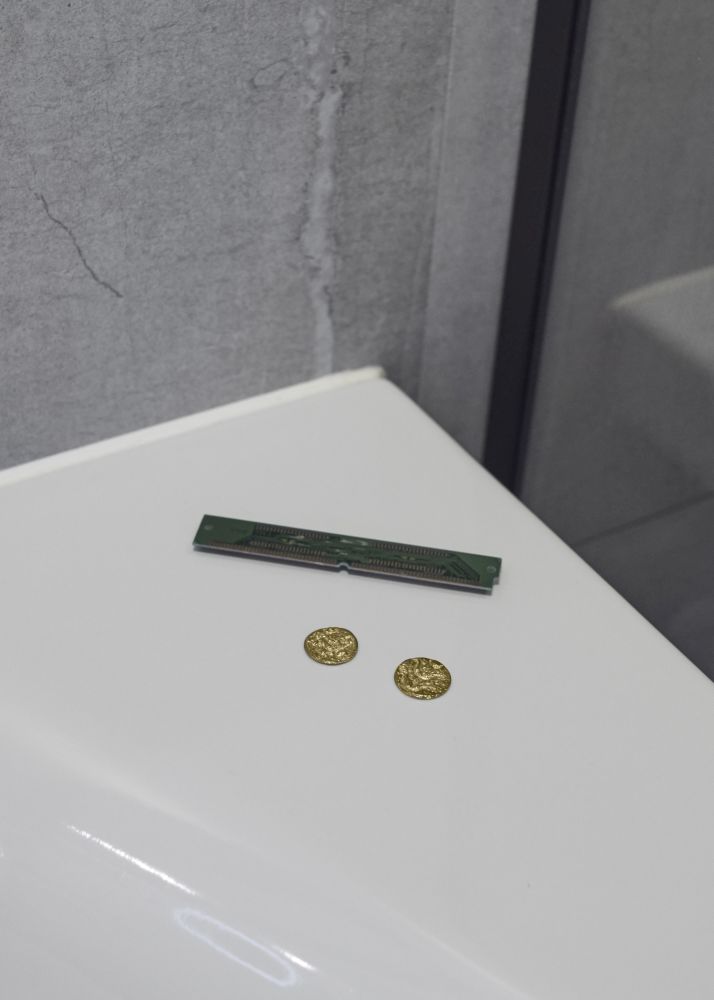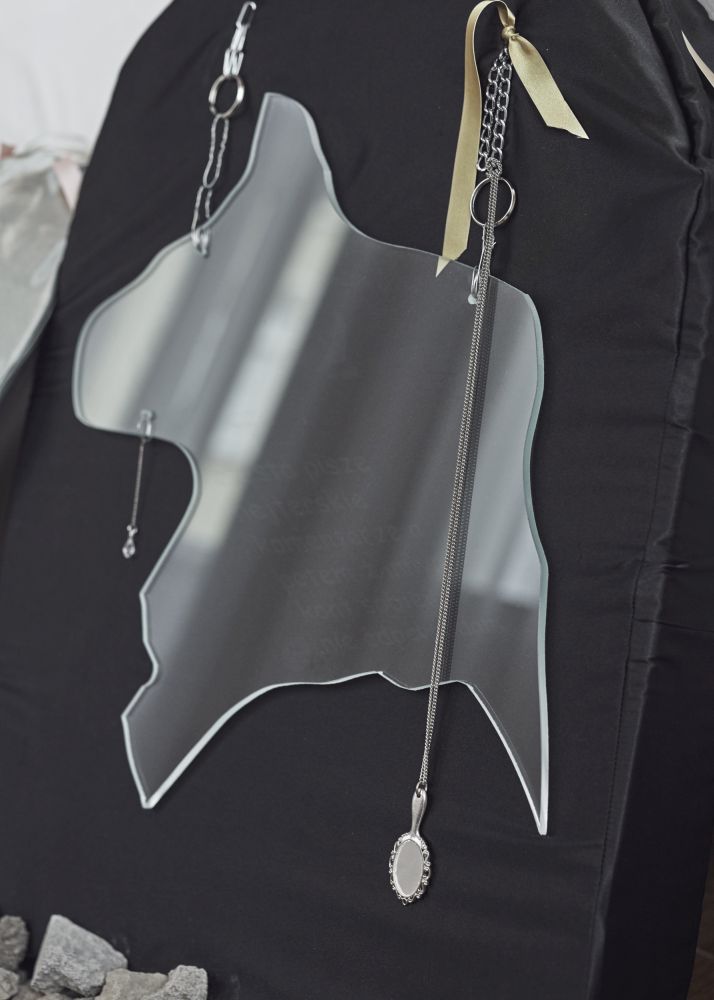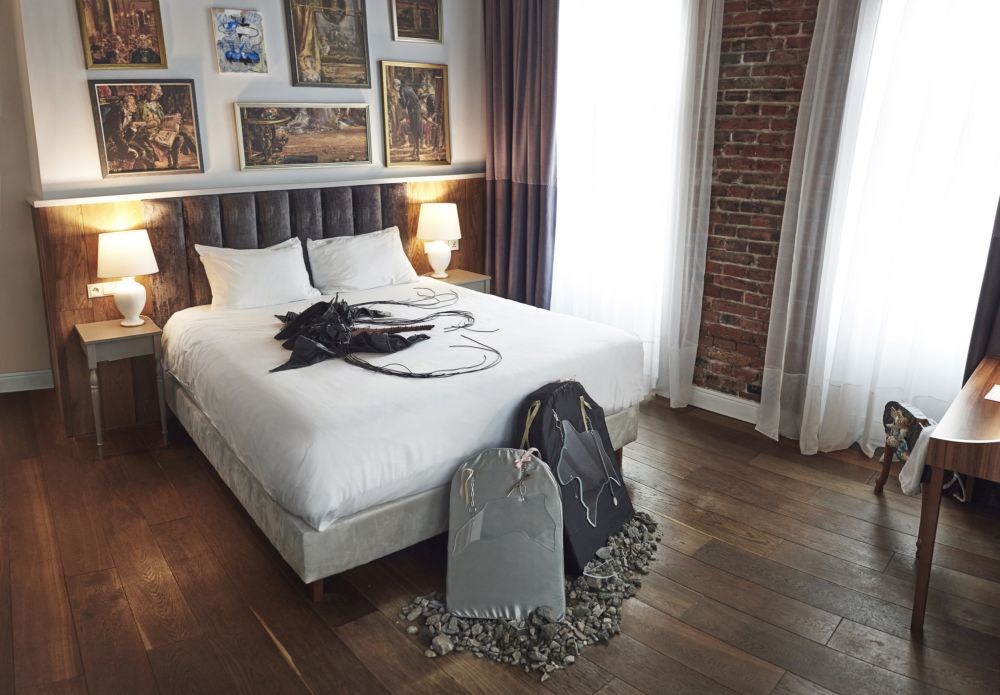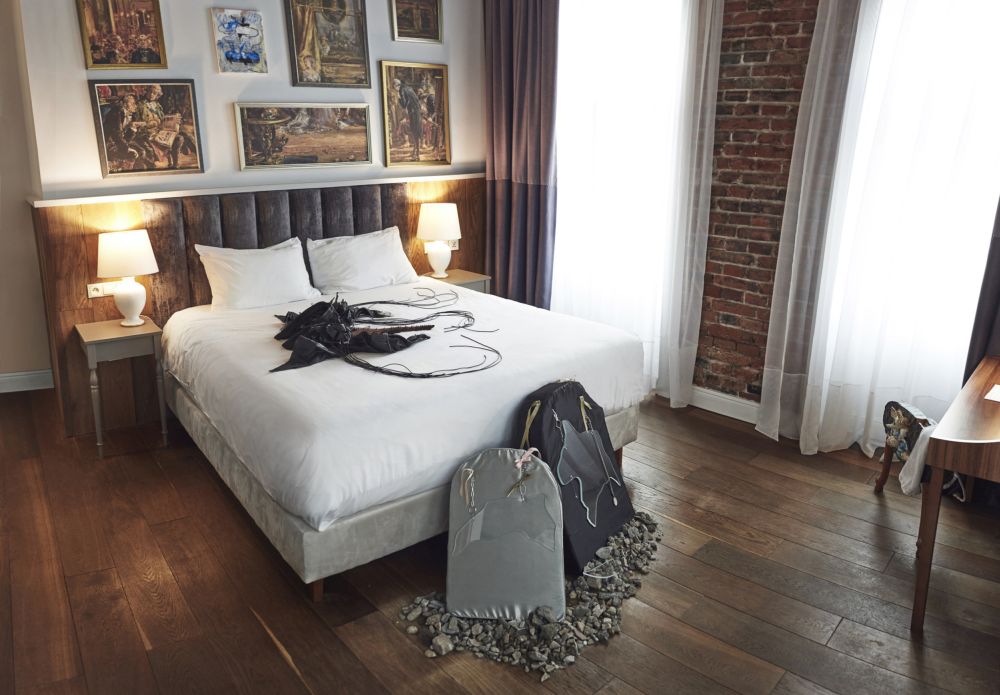Artists: Justyna Górowska, Inside Job (Ula Lucińska, Michał Knychaus), Karolina Jarzębak, Wiktoria Walendzik, Kuba Gliński
Curators: Ania Batko, Aleksander Celusta
Coordinator: Mateusz Piegza
Graphic design: Renata Motyka
Translation: Dorota Wąsik
Photography: all images copyright and courtesy of the artist and Henryk Fundacja (Poland)
Organizer: Henryk Fundacja (Poland)
Venue: Matejko Room, Hotel Indigo Old Town Kraków (18, Św. Filipa street, Krakow, Poland)

It is a luxury hotel. As the narrator Ijon Tichy says, even if it fails to save soft-boiled eggs from overcooking, it still is excellent. Especially since no hotel comes with an in-house chicken coop. The H****n has one hundred and six floors and is nearly empty. Inside there are swimming pools, solariums, tennis courts, go-kart racing tracks, roulette tables, and merry-go-rounds. There is also a shooting range where you can target selected (and previously suitably stuffed) people, and a bandstand with the option of spraying the audience with tear gas. The room offers a breathtaking view of the glaucous brown clouds of smog. A spool of standard Alpine rope hangs in the jade and jasper bathroom, and next to it there is a pole, standing three meters high. There is a camouflage cape hidden in the closet, and a sack of hardtack biscuits under the bed. On the door there is a sign: “This Room Guaranteed BOMB-FREE. From the Management”. Each of the items in the luxury suite is meant to increase the chances of hotel guest’s survival. Even the water in the tap is oozing hallucinatory fumes. …Say someone imagines that he is only imagining that he doesn’t imagine – or the other way round.
This is where the eighth Congress of Futurologists is to take place. The gathering to talk about overpopulation and the impending demographic catastrophe gets inaugurated, but it never actually happens. Moments after the conference begins, riots break out in the streets, soon escalating to a civil war. But the latter does not impress anyone, not anymore. After all, this is happening in a politically unstable world, torn by uncontrolled outbursts of social rage, and even more violent reactions from the authorities. Some congress participants, Tichy included, join the management in going down to the sewers. They breathe air polluted with hallucinogens, which the authorities have used to suppress the revolution. Our narrator is taken to the hospital, where he is induced into hibernation. He wakes up in 2039, in a perfect world. He soon discovers that it is merely powder and dust. A corpse, albeit well preserved. The apparent idyll is due to the chemical substances that program emotions, sensations, and social reflexes, even as the world, or rather the universe, is tending towards its inevitable destruction. And if it must perish, let it at least not suffer.
Stanisław Lem narrates all this in his short story “The Futurological Congress”, published in 1970. The piece is of the funny-scary genre. It is laughter through tears. Also, because this is not the first time that Lem predicted the future. Last year on Earth has been a real countdown of horrors. We wish to spare you, so we will mention just a few. Environmental, migration, social and economic crises. Conflicts on the grounds of gender, race and sexual orientation. An anthropocentric structure, which reproduces hierarchy, violence, and domination by some people at the expense of others. In the newspapers, we read about a secret climate summit in Sicily, where technology sharks and celebrities have flown in, aboard one hundred and fourteen private jets. They emitted nearly 55 thousand tons of carbon dioxide and talked about global warming. Most of them are no environmental experts, but like in Lem’s book, they do not stand idly by when they hear the cry of “Man the pumps!” In that same year, a report by independent scientists from Melbourne hit the media, predicting that as a result of climate change, related migrations and wars, our civilization will be gone by the year 2050. One of the theses of the report assumes that over 30% of the land globally, and 55% of the world’s population will be exposed to lethal conditions, beyond the threshold of human survival, for 20 days every year. Fortunately, conditions at the H****n hotel will remain tolerable. We are watching George Floyd’s death on YouTube, and on Twitter, we’re reading Trump’s comments. As riots break out in the US at the height of the coronavirus pandemic, he writes: “When the looting starts, the shooting starts.” Meanwhile, just before the elections, Poland’s president states that LGBT (reminder: Lesbians Gays Bisexuals Transgender) are “not people”.
If only we could – as it is possible in Lem’s fiction – we would run away into the galaxy, hoping that the worst would happen in our absence. With fear, but also with relief, we would be watching the Earth turn into an overcooked potato.
We keep this civilisation narcotised, for otherwise it could not endure itself. In Lem’s story, these words are spoken by Symington, the controller of the illusion. An eschatological narcotiser and the world’s last Atlas, whose work consists in pleasing people who remain unaware of their collective agony. In his own words, he is basically an artist, and in a field that is entirely new, untouched. He cannot change the truth, therefore he hides it. What if – although that of course never happens – he went for a subversive gesture, and revealed the truth, like a magician in slow motion pulling a rabbit out of a hat? When a female intern asks Tichy if he gives his consent to being vitrified, he only replies: “Sorry, I don’t talk to apparitions”.
We are more interested in futurology than the future, and in the human hencity that is going to replace it. Also in the past ideas of the future. Visions of what reality has been or is going to be, and a vision of that reality without us. But also the present, which lately is impossible to watch unless we imagine that it is a movie that we’re watching. Or just another hallucination. Like a cellophane-wrapped alarm clock that someone dropped at a US corporate hotel pretending it was a bomb. Rather like congress participants, on the roof of another hotel, we are sipping wine. The vernissage is underway. A panoramic view of Kraków is stretched before us. Until recently, the entire city was depopulated. It was empty and dark. The Market Square, at midnight, would feel like a stage set of a disaster movie. We would love to tell you more, but we are afraid you would not endure that. What if there is no future?
When there is no bread – let them eat opium! Lem writes. Bread and circuses! They have no bread? Let them eat cake! We are merely conversing with apparitions.
***
“The Futurological Congress” was initially published in instalments, in the “Szpilki” journal, hence the idea to organize an exhibition divided in time and space into autonomous segments. In the context of Lem’s novel, we are interested not only in its Chinese box structure, in its critical and ironic reflection on futurology, but also in the thesis that impoverishing the world is accompanied by an escape into virtual space. The exhibition, although it might as well be a movie, takes place in two mutually complementary dimensions: the analogue reality of a hotel room, and the virtual reality of Instagram, in the form of process documentation, film footage, and video performance. Both are producing moments of relief, and hallucinatory conversations with apparitions.
The exhibition is part of: “The Futurological Congress. An interdisciplinary arts project focused around Stanisław Lem’s work”.













